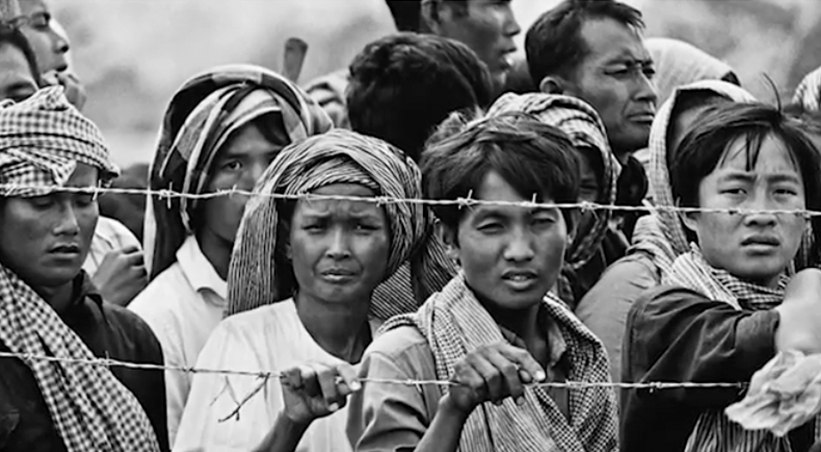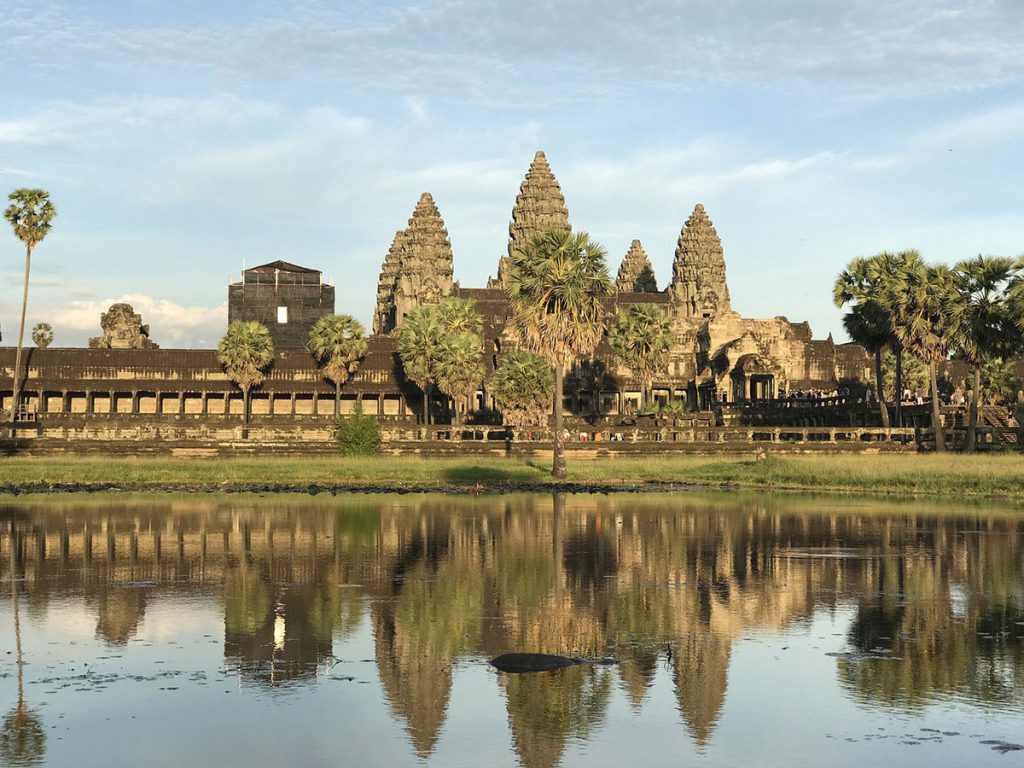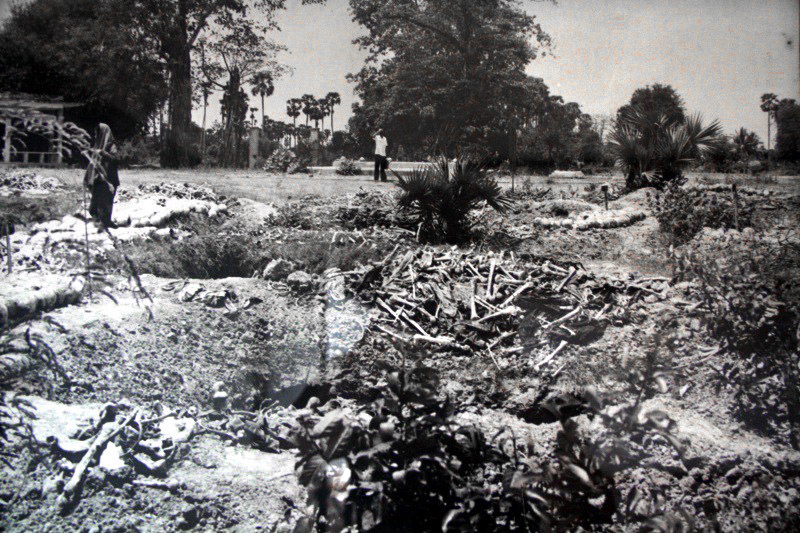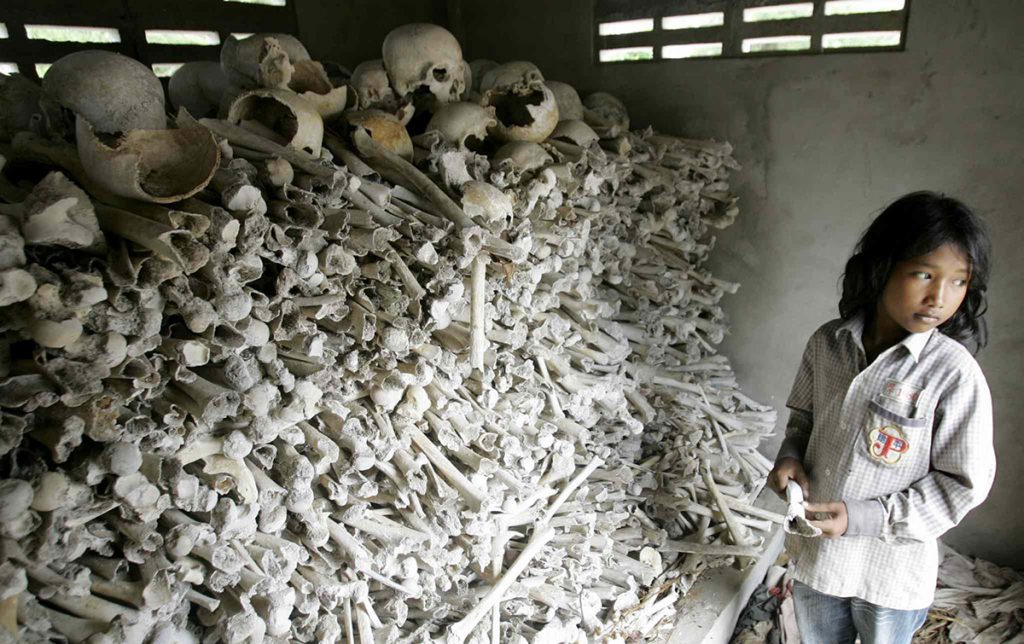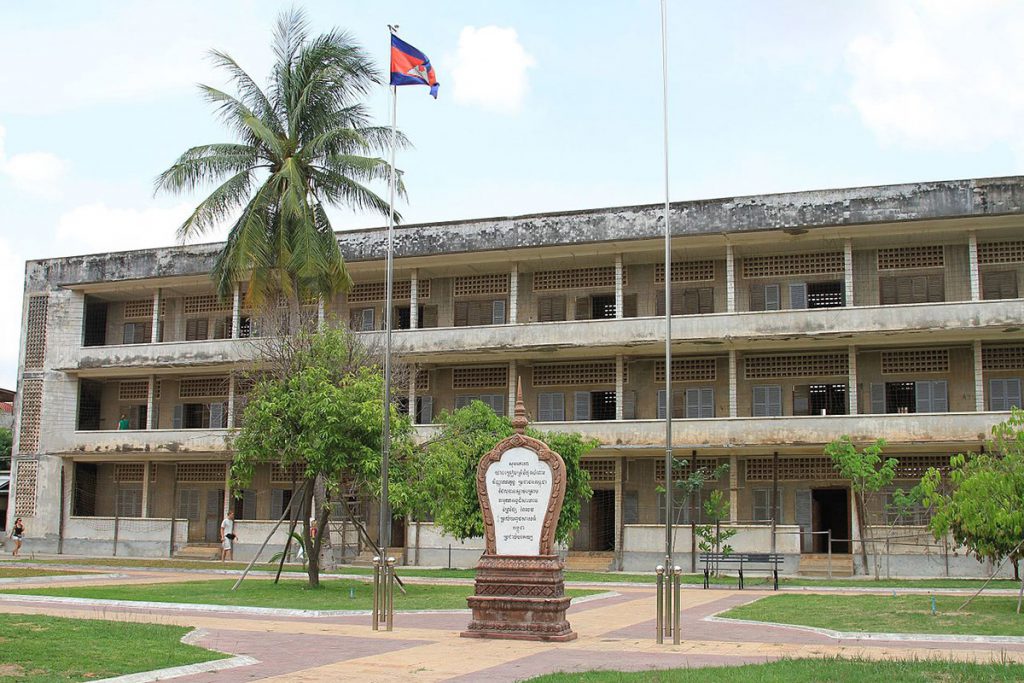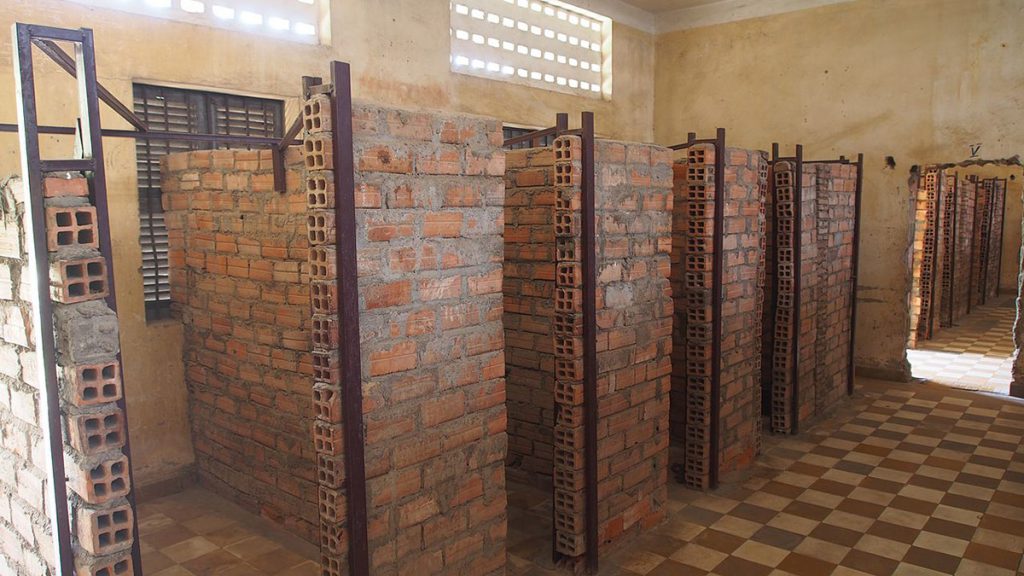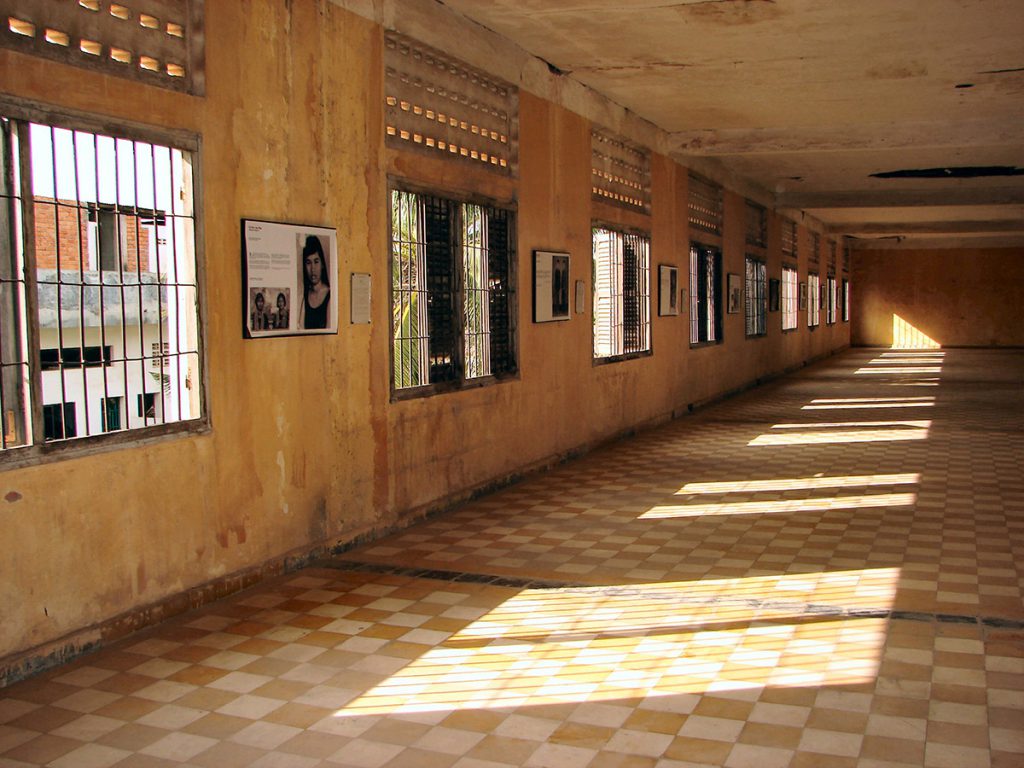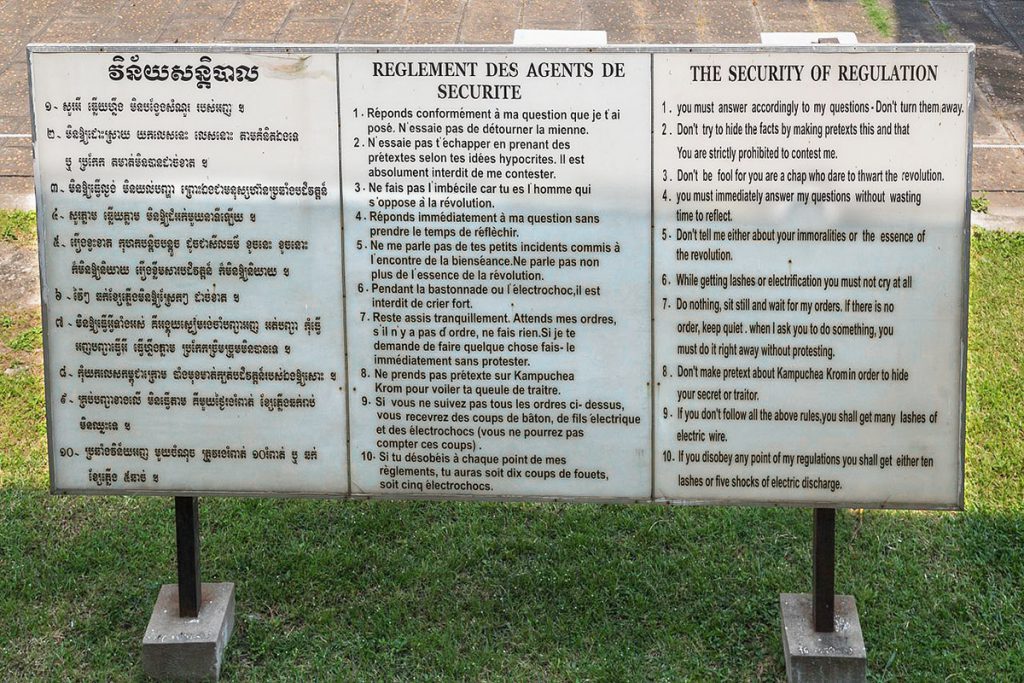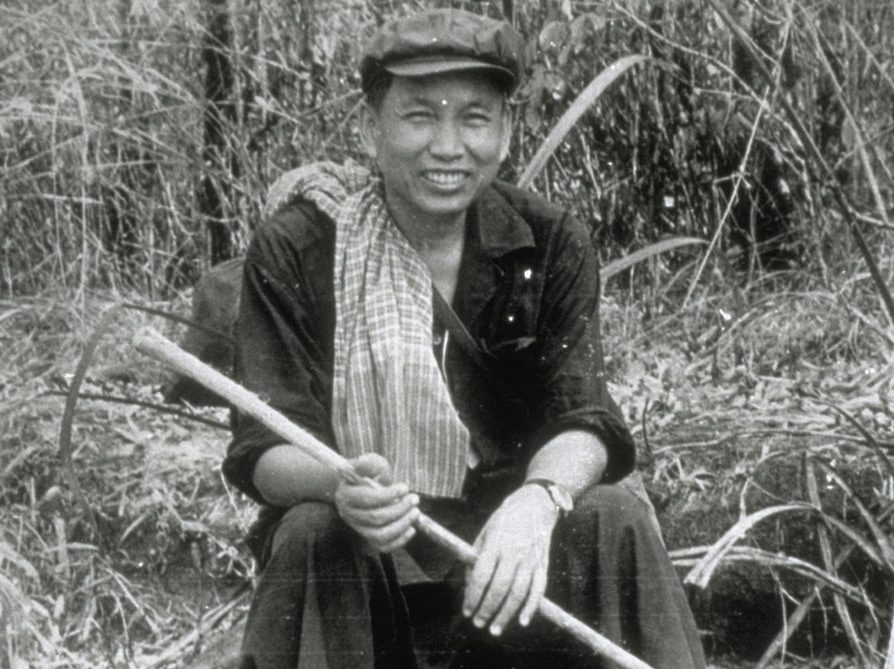Educator Tools

 Ask yourself:
Ask yourself:
- Have you come across any references in your courses, textbooks, or the news about Cambodia?
- Do you know where Cambodia is without looking at a map?
- How should the genocide be remembered?
- How can the Cambodian genocide be compared to other genocides in this unit?
- The region now called Cambodia has had many names throughout its history: Funan, Angkor Empire, Khmer Empire, Kingdom of Cambodia, Khmer Republic, Democratic Kampuchea, People’s Republic of Kampuchea, and State of Cambodia. What do these frequent name changes suggest about its history?
Cambodia: A Brief History
Hinduism and Buddhism influenced Cambodia throughout its history like other states in Southeast Asia, though most Cambodians today follow Buddhist practices. Its national language has influences from India rather than China, despite China’s influence in the region over time. The original state, Funan, morphed into the Angkor Empire under a series of powerful Khmer rulers from the 9th to 12th centuries CE. At its peak, this empire included parts of Vietnam, Thailand, Laos, and Burma (Myanmar). The rulers built an impressive series of more than a thousand temples. Some of these are popular tourist attractions, in particular Angkor Wat Temple, a UNESCO Heritage site north of Siem Riep built in the 1100s.
ACTION 1
Do
Search Google Maps and find a map of Cambodia and Southeast Asia. Zoom in and trace the route of the Mekong River, the longest river in the area. Since river travel was very important historically, how could the river influence history in the area, both positively and negatively?
Like so many empires, after a period of regional dominance, things changed and by the 1400s Cambodian power was surpassed, first by other powers in the region such as Siam (Thailand) and Vietnam, and later by European colonial powers. In the case of Cambodia, it came under the influence of France like its neighbour, Vietnam. Japan took over the area briefly during World War II. This was followed by struggles for independence from France, which was achieved in 1953. Throughout colonial history, borders were set without consulting the peoples who lived in the area. In this case, the mixture of Vietnamese and Cambodian Khmers led to tensions between the two groups.
Communism in Cambodia
In the 1960s and early 1970s, the Cold War in Asia involved the United States and the People’s Republic of China, and supporters of both sides. This eventually brought instability to the region and Cambodia was not spared. The Vietnam War (eventually won by the communist north in 1975) spilled into Cambodia with a military coup, an insurgent campaign by Cambodian communists led by Pol Pot, and thousands of bombs dropped by the United States to support the military government against both Vietnamese and Cambodian communists. The thousands of civilian casualties were a recruitment tool for the Khmer Rouge, Cambodia’s communists. Pol Pot and many other founders of the Khmer Rouge were well-educated students who had lived in France, yet, like their Vietnamese classmates, they felt alienated by the post-independence Kingdom of Cambodia. Both groups were attracted to communist ideas.
This Really Happened
In April 1975, the Khmer Rouge forces defeated the Cambodian military and took over the capital city, Phnom Penh. Urban areas supported the military when it first came to power. Though their support cooled due to government dictatorial policies. People were even more afraid of the Khmer Rouge so they fled the cities or were forced out. Many of them, likely millions, were forced into unpaid agricultural work.
The Khmer Rouge engaged in a wave of killings in the four years it controlled the country. After killing many supporters and soldiers connected to the previous military government, they brutalized Buddhist monks and ethnic minorities including Chinese, Vietnamese, Thais, and others not connected to the Khmer majority population. The new government also cut Democratic Kampuchea (the new name for Cambodia) off from the rest of the world.
Purges continued with anyone suspected of disloyalty, even communists who disagreed with the Pol Pot regime and former urban dwellers who were already starving after evacuating the cities to live in the countryside. Peasants were also persecuted. The death toll between 1975 and 1979 was estimated to be at least 1.7 million victims of murder, starvation, overwork or disease (out of a population of about 8 million) during this reign of terror. One in four or one in five Cambodians died within just four years. The Khmer Rouge even killed children and babies, since by killing them they would not grow up to take revenge for the deaths of their parents.
Money, free markets, schools, private property, foreign styles of clothing, religious practices, and other aspects of Khmer culture were abolished, and buildings such as schools, pagodas, and government properties were turned into prisons, stables, camps, and granaries. Family relationships were heavily criticized, and the Khmer Rouge forced children to be child soldiers since they were easy to control and would follow orders without hesitation, to the point where many were forced to shoot their own parents.
ACTION 2
Discuss
A phrase that the Khmer Rouge used when describing some of the Khmer they killed was that these were “Khmer bodies with Vietnamese minds”. What does this say about relations between the two countries even though both were considered communists in the Cold War period?
The Killing Fields
Tourists now visit graves and memorials to the over 150 Khmer Rouge “Killing Fields” as well as ancient wonders like Angkor Wat. In addition to political opponents, those unable to do farm work in the fields were marked for execution. Approximately 60% of the deaths during the genocide were by direct execution and the remaining victims died from disease or starvation. There were more than 20,000 mass graves containing the bodies and bones of nearly a million and a half victims. The term “Killing Fields” was coined by a Cambodian journalist, Dith Pran, who managed to escape. His experiences and those of an American journalist, Sydney Schanberg, were the basis for a 1984 British film, The Killing Fields. The film was nominated for and won several Academy Awards.
ACTION 3
Do
A. Imagine if you were one of the victims in these photos. What would you say to the survivors? Write a dialogue that might take place in that scenario. What questions would you have for them?
B. After watching the movie, “The Killing Fields”, how might your thoughts be affected by the previous activity? What does this say about the power and limits of the media, whether fiction or non-fiction, to inform us?
A High School Reunion
“Hill of the Poisonous Trees” (Tuol Sleng) was a former high school used by the Khmer Rouge as just one of at least 150 execution centres.
Imagine taking a tour of your old high school like this:
Discuss
Among those marked for imprisonment and execution were people wearing eyeglasses. Why do you think they were selected?
Aftermath
The Khmer Rouge had a belief in the superiority of their people (i.e., the majority Khmer people). This was evident in their attacks on non-Khmers in Cambodia as well as attacks on several of their neighbours, including Vietnam, ruled by fellow communists whom one would expect to be on the same side. Refugees from Cambodia fled to Vietnam and lobbied to get that country’s support. When Cambodia declined to negotiate with Vietnam over the border fighting, the Vietnamese army invaded and overthrew the Khmer Rouge and set up the People’s Republic of Kampuchea. After a decade, the Vietnamese withdrew the last of their troops and the government renamed the country the State of Cambodia. Over the years, under United Nations support, Cambodia emerged as a democracy with free elections and the return of the monarchy as a symbol of national unity.
What Happened to the Khmer Rouge?
Many Khmer Rouge members who were considered moderate were killed; their leaders fled. Pol Pot, with some supporters, hid out along the border of Cambodia and Thailand, making rare appearances to denounce the Vietnamese invaders and anyone who supported them. The People’s Republic of China were supportive of remnants of the Khmer Rouge. Gradually, the government in Cambodia persuaded Khmer Rouge members to defect. In 1998, Pol Pot died while taking a nap. A few of his remaining supporters mourned his death.
In 1997, the Cambodian government, with help from the UN, established a tribunal to investigate the genocide. It took nine years to agree to the shape and structure of the court – a hybrid of Cambodian and international laws. The investigating judges were presented with the names of five suspects by the prosecution in July of 2007. On September 19, 2007, Nuon Chea, second in command of the Khmer Rouge and its most senior surviving member, was charged with war crimes and crimes against humanity. Facing Cambodian and foreign judges at the special genocide tribunal, he was convicted on August 7, 2014 and received a life sentence. On July 26, 2010, Kang Kek Leu, the director of the S-21 prison camp, was convicted of crimes against humanity and sentenced to 35 years of imprisonment. In 2012, his sentence was extended to life imprisonment.
ACTION 4
Do
List the reasons why Khmer Rouge leaders avoided trials for decades and why Pol Pot escaped justice. Compare your list with a classmate.
International Response
The international community was largely silent during the course of the Cambodian genocide. Neither the U.S. nor Europe called attention to the genocide as it was happening, although scholars and others in the West tried to bring attention to the atrocities being committed.
ACTION 5
iSearch
Yale University has an ongoing study of the Cambodian (and other) genocide. Explore the sections on U.S. involvement on their website.
What information helps explain the lack of response from the United States and other countries?
ACTION 6
Do
Two common expressions that are often used to explain how things happen are
“The enemy of my enemy is my friend.”
“Once bitten, twice shy.”
Discuss and record your answers to the following questions:
A. How do these expressions apply to the reaction of the United States to events in Cambodia?
B. What conflicts in the world today persist because of the ideas conveyed in these expressions?
C. What can Canadians do when faced with situations that offer less than perfect choices?
Literary Insights that Inform History
Like people throughout the world, the Khmer people created folktales over the centuries. Elders passed stories on to their children, sometimes to teach and other times to entertain. However, in this ancient land with powerful animals like elephants, tigers, and cobras, some tales have a surprising hero: a small rabbit! Mr. Hare uses his brain to make up for his size. Time and again, he outsmarts huge elephants, hungry crocodiles, fierce tigers . . . and even men.
ACTION 7
Do
Read the Khmer folk tale: How the Hare Crossed the River on the Crocodile’s Back
Given the history of Cambodia, might this tale be an allegory? If so, who is the rabbit and who is the crocodile? What purpose do allegories serve?
In many ways, How the Hare Crossed the River on the Crocodile’s Back resembles a fable. What are the characteristics of a fable? Why might this Cambodian tale be described as a fable?
Do some research into the Khmer era described in this unit. Select an event that you find interesting and create a fable to present it. Your fable should be between 400-500 words. Select one of the following methods of presentation: a Powerpoint presentation (include illustrations with your slides); a dramatization (invite some of your classmates to participate); or story-telling.
ACTION 8
iSearch
Do an Internet search for other Khmer folk tales.
A. What message or lesson is embedded in each story?
B. Can you think of a Western folk tale or fable that presents the same lesson?
C. What does this suggest about the human condition?
Additional Resources
Loung Un, First They Killed My Father: A Daughter of Cambodia Remembers (Harper Collins, 2000)
First They Killed My Father, film directed by Angelina Jolie, available on Netflix
Tuol Sleng Genocide Museum, Phnom Penh
Every effort has been made to gain permission from copyright holders to reproduce borrowed material. The publishers apologize for any errors and will be pleased to rectify them in subsequent reprints and website programming
Educator Tools


